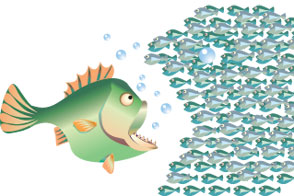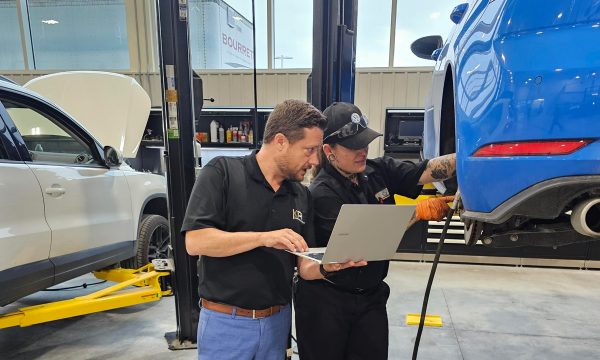What the big guys can learn from their smaller counterparts
There’s a lot to be said for keeping a lid on growth! Despite the apparent trend to large dealer groups and mega-dealers, smaller dealerships are thriving in Canada. Why is that the case? And how do they do it, especially in the business office?
According to industry expert Dennis DesRosiers, it’s the larger dealerships that lost market share during the last two difficult years. In a February press release he reported, “Mega dealers accounted for 10.1 percent of sales in 2007 but have since fallen to only 8.4 percent of sales. And large dealers peaked at 24.4 percent of the market but have fallen back to only 19.7 percent. The smallest stores held share and the mid-sized stores picked up market share.”
DesRosiers says the common attitude within some OEMs is to get rid of their smallest stores and let the larger stores become stronger. “But there is little evidence that larger stores will actually get stronger with dealer consolidation,” he adds.
Advantages for small dealers
There are inherent advantages for the owner of a small dealership. For one thing, the dealer is usually in the store. Scot Birnie bought Riverside Ford in Brockville, ON three years ago, and since then sales have gone from an average of 12 units a month to 40-50. Birnie is very hands on, but he also gives staff a lot of autonomy to make decisions. He follows his father’s advice to “always be above fair. In a small store, you have to do everything above board. There’s no room to hide.”
In a smaller business, employees can see how their efforts effect the bottom line. And they often have a variety of responsibilities which in turn enhances their value to the company. As Scot Birnie knows, given the right incentives, everyone on staff starts getting creative. And small business relies more on creativity to improve and grow.
In Cobourg, ON, Mario Pareja (Cobourg Kia) agrees. His dealership has an annual volume of 220 new and used and enjoys a 4.5 percent share of the Cobourg market, substantially ahead of the brand’s national share of 2.4 percent. “We have regular round-table meetings with the whole staff. Everyone comes with their ideas. They all wear several hats, so they are more creative about what they’re doing,” he says. And a small agile company can adapt more quickly to a changing business environment. When you want to make changes, says Pareja, it’s easier to get everyone on side with your decisions.
It’s also important with a small staff to consider an employee’s family needs. Pareja is quite lenient about his people taking time off for kids’ appointments and the like. His reward is a team that works well together.
Close to the customers
Taking good care of customers is the only option and repeat business is critical. “More than 50 percent of our sales are repeat sales. That’s the secret,” Pareja confides. “It’s the personal touch. Big-city dealerships tend to be run by staff. I’m here six days a week and customers like it that the owner is always on the premises.”
Roger Johnson also believes small dealerships do well because they’re closer to their customers. Johnson handles sales and finance at 5th and Carney Subaru, in Prince George, BC. He says customers feel they’re talking to someone who really cares. “This is particularly important when there are issues. They know us and know our focus is their best interest. And because we’re small, we can make decisions then and there. They don’t have to fill out forms in triplicate and they don’t have to deal with layers of management here or at the factory.”
Duane Rath (Blaikie’s Dodge Chrysler, Truro, NS) continues with that theme. “We’re working on a more personal basis and we’re not as rushed. Our service advisers know all our customers by name and there’s a lot more interaction,” he says. And smaller dealers are usually a more important part of their community, he adds. “Towns that have lost their GM dealerships are really missing them. They were often a major contributor to events and teams.”
Business office challenges
There are particular challenges for the small dealer when it comes to managing the business office. According to 2007 stats from NADA, 28.5 percent of the profit made from selling a new or used vehicle is generated by the F&I (finance and insurance) office. Dealers know it’s a key part of every deal. But typically the small dealership has just one business manager. So what to do on his or her day off?
The problem, says Duane Rath, is there’s too much work for one person, but not enough for two business managers. His solution is to always have a back-up. His senior salesperson is cross-trained to do the BM’s job when he’s not available. “I always have someone training for the business office and the bonus is, it can lead to a promotion for that person.”
It’s important to schedule properly, especially for deliveries, and everyone at Blaikie’s watches for traffic jams around the business office. To help out, sales staff might get the credit app going or arrange for the customer to come back another time or otherwise keep the customer engaged while he/she’s waiting. Rath says he has to be constantly inventive, but in Truro, some customers don’t mind waiting a bit. “The important thing is not to panic if it’s looking too busy.”
Flexibility is the answer at Cobourg Kia. Mario Pareja’s business manager officially puts in a 40 hour week, but the day we spoke was her day off. Nevertheless, she’d already been into the dealership to work on a couple of deals. She lives a few blocks away so when things are not so busy, she can take a little extra time off.
At 5th & Carney Subaru, two people are trained to manage the business office, and they work hard at making sure one of them is always in the store. Subaru customers tend to be better educated and often want to get into the financial side early on in the sales process. “And if we’re not available for some reason, our sales people have to be very straightforward and say we’ll email them with the answers.”
Overcoming the tough sell
Johnson admits it’s a bit tricky selling extended warranties to Subaru buyers. Customers tend to resist, asking, “Why do I need that? Nothing ever goes wrong.” So they consider the customer’s driving cycle, and tailor their approach to the customer’s driving habits.
Scot Birnie was looking at ways to improve the bottom line, and in a poor business climate, he decided the best potential for growth and profit was in the business office. “We wanted to keep it simple and concentrate on just two goals – customer satisfaction and extended warranty sales. A secondary goal was to drive traffic into the back shop which in turn, helps build loyalty. Ford’s products, the Extended Services Package and their Ford Maintenance Protection Package, are helping us achieve this.”
Birnie invested $10,000 in a two day training session for his business manager and two service advisors. While it was a big expense initially, this consultant was so confident of the results that he guaranteed a $90,000 increase in net sales in the business office within a certain timeframe, or he’d refund his fee! The trainer showed staff how to present the products in a very structured way, and he had good research material which demonstrated the cost effectiveness of the Ford products. Within six weeks Birnie had recovered his investment, and in the first quarter, Riverside Ford led the region in extended warranty sales. Their penetration had been in the 20-25 percent range and it’s now up to 60 percent for new and 50 percent for used.
Growth is essential
Even though they’re small dealers, continuous growth is still essential. As Duane Rath puts it, “You’re always thinking about growing. If you’re standing still you’re going backwards.” But you have to grow where necessary, not necessarily grow. For the Subaru store in Prince George, that will be the service department where they’re currently adding four service bays to their existing three to handle demand.
And you have to understand where you want to go and why. For Scot Birnie it’s more about time than money. If he can increase his business to 60 units a month it will allow him to bring on a couple more people, and he’ll have more time for his young family.
Mario Pareja’s ambitions dovetail nicely with Kia’s corporate goals. Kia expects to double their volume by 2013, and then stabilize. Pareja is happy to work towards those targets. With the addition of one more service bay, he’ll have the facilities to double sales. And that will be big enough.
Duane Rath sums it up well. “It’s good to be a bigger fish in a smaller pond.”











